Digging with a twist: What are the advantages of a tiltrotator?
18 May 2023
Construction sites are consistently looking to increase efficiency and move with fewer machine movements. Catrin Jones looks at how tiltrotators can play a key role in the future of construction.
Popular in Scandinavia, and growing in other areas of Europe, the tiltrotator is deemed to significantly increase machine efficiency.
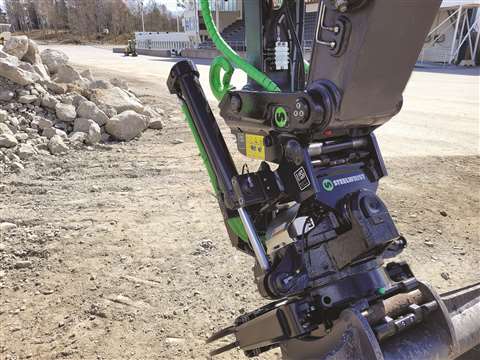 Steelwrist X14 tiltrotator (Photo: Steelwrist)
Steelwrist X14 tiltrotator (Photo: Steelwrist)
The tiltrotator can look like a confusing bit of kit but it is possible to think of it as a wrist that directly connects to the excavator’s arm or beneath the excavator’s quick hitch. The tiltrotator is then connected to the excavator’s hydraulics and electrical system. Depending on the excavator’s extra hydraulics, control is adapted to suit different types of control system.
In the early 1980s, the Norgrens family introduced the Tiltrotator to the Swedish market under their family-owned and operated company Noreco, and since then it has become a standard in the Scandinavian region. The concept has also recently gained popularity in many other countries across the globe, including the Netherlands, Germany, the United Kingdom, Japan, Canada, and the United States.
Tiltrotator attachment advantages
Sven-Roger Ekström, senior product manager at Rototilt, understands the capabilities of tiltrotators better than most and believes that they have several benefits that could change the way we work on construction sites.
Upon asking Ekström why everyone should have a tiltrotator, he reels off a list of what he believes are the key advantages. “Your excavator becomes an efficient tool carrier in addition to working faster and more flexibly with fewer machine movements.”
Ekström adds that such qualities allow companies to take on new types of jobs and will require less manual labour around the machine.
Unfortunately, the skills shortage is as much a concern as it was in 2022 and including a new attachment into the field can cause apprehension for potential buyers, who may be uncertain about imposing such a complex attachment on operators.
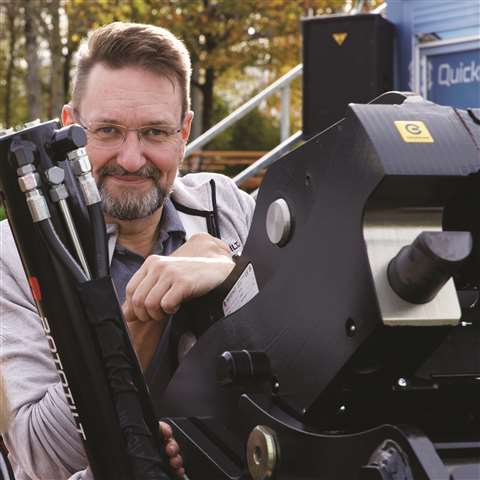 Sven-Roger Ekstrom, Rototilt (Photo: Rototilt)
Sven-Roger Ekstrom, Rototilt (Photo: Rototilt)
Ekström, however, says it takes only a short time to become proficient with a tiltrotator. “If you are a skilled excavator operator you will need 1-2 weeks to perform really well. After that first jumpstart, you will start to see new opportunities such as how to solve working tasks in a new way and become even more efficient.”
Safety first
Stefan Stockhaus, CEO of Steelwrist, believes that tiltrotators are also the answer to increasing safety in potentially dangerous working conditions. By using tiltrotators, jobs traditionally done outside the cabin can be moved into the cabin, removing ground workers from risk-prone roles. “It’s not all about efficiency,” he says. “It’s also about safety and becomes an alternative to a standard factor.”
Increasing efficiency is undoubtedly a huge advantage on the modern-day construction site and Ekström says tiltrotators can increase efficiency by 25% to 30% depending on the type of job. “On some jobs where you, with the combination excavator plus tiltrotator, can do the same job as two or three standard excavators you of course calculate with even higher figures,” he adds.
 Stefan Stockhaus (Photo: Steelwrist)
Stefan Stockhaus (Photo: Steelwrist)
Steelwrist’s Stockhaus agrees with Rototilt’s Ekström regarding his sentiments on the tiltrotators ability to increase efficiency, but he adds that enjoyment is also a benefit. “In our case, 96% of all the experienced users say that the job is more fun. And if the job is more fun, it’s easier to attract good employees. Those are two really strong cases. As I see it anyway – efficiency, profitability, but also more fun.”
Winning projects using tiltrotators
Mature markets, such as Scandinavia, have embraced the adoption of tiltrotators. Almost 90% of excavators in the region have the attachment, which is said to be crucial to winning projects as well as meeting specific sustainability goals.
While Scandinavia has fully adopted this form of attachment, the rest of Europe is somewhat slower. “It always take time to break new ground and to change old habits,” says Ekström.
“In Scandinavia, we have a long practice of getting more efficient because of expensive, and the lack of manual labour. We also have a market with many small contractors that often see the owner in the cab working with the equipment; therefore, he can quickly see the benefit of working in a new way.”
Stockhaus believes the popularity surrounding tiltrotators in Scandinavia comes from the region’s pressure on increased productivity – it is also the key to getting jobs.
Elsewhere in Europe, Ekström says that big companies with a large rental market often take longer to see the benefits. Other obstacles, he says, can be that as long as the contractors are satisfied with buying two or three machines instead of one machine with a tiltrotator, the dealers will not push the product until the customer asks for it.
Expanding the portfolio
Autumn 2022 saw Rototilt launch its Rototilt Control product concept featuring tiltrotators, joysticks, a new control system and a remote support app. The product has become well established in the market and companies are starting to realise their potential – Rototilt are now expanding the number of tiltrotators in their RC series.
The company confirmed that Rototilt’s R4 and R8 tiltrotators will gain counterparts in the RC series launched at Bauma last year. This means that Rototilt’s new RC System control system and the new RC Joysticks will be available to machines weighing between 10 and 43 tonnes.
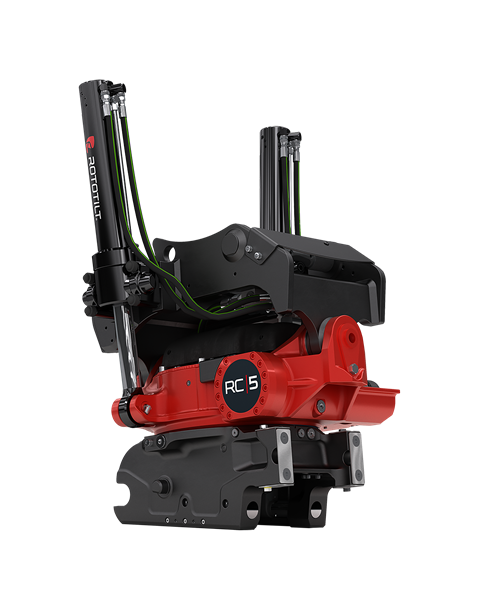 Rototilt’s newest tiltrotator, the RC series (Photo: Rototilt)
Rototilt’s newest tiltrotator, the RC series (Photo: Rototilt)
The R4 tiltrotator has historically been one of Rototilt’s most popular products, according to Ekström, who has high expectations ahead of the sales launch.
He says, “We started in the mid-range but are now expanding the concept to encompass both bigger and small machines. Today we are delighted to offer increased energy efficiency and an improved driving experience for a wider range of machines and users.”
The new tiltrotator series, due to launch in February 2023, features pressure-compensated hydraulics and is said to deliver greater energy efficiency than its predecessors, in addition to enabling more controlled excavation movements.
Setting the industry standard
As part of a joint initiative, Steelwrist and Rototilt have come together to set an industry standard for fully automated quick couplers under the Open-S Alliance. The non-profit organisation sets out to develop and promote the Open-S standard, with the ultimate aim of achieving global interchangeability between quick couplers, tiltrotators and work tools for excavators.
The alliance’s standardisation work has been ongoing for the last two years with the purpose to increase safety and efficiency for excavator owners, operators and ground personnel.
The partnership has started to create a uniform manufacturing standard for dimensions and tolerances as well as making it cost efficient to retrofit adaptor brackets to used and new buckets and work tools.
In 2021, Volvo Construction Equipment became the first excavator specialist to join the alliance in hopes to work with other industry partners on improving work tools for excavators. The demand for fully automatic quick couplers on excavators has continued to grow rapidly in general construction and it is said that all partners are seeing opportunities for growth in a variety of sectors.
Steelwrist and Rototilt are paving the way for the future of tiltrotators, in addition to the likes of Volvo Construction Equipment and Caterpillar. Scandinavia needs no convincing evidence of the advantages of tiltrotators and it seems the rest of Europe is taking a particular interest in increasing efficiency.
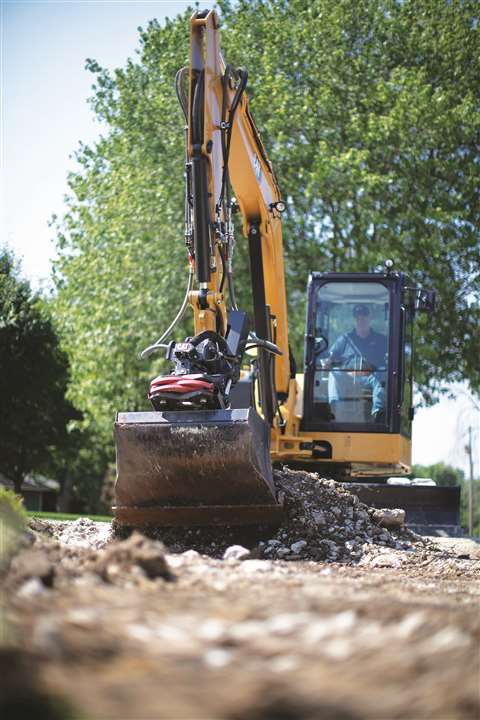 Caterpillar expands TRS offering to work with Cat Mini Excavators (Photo: Rototilt)
Caterpillar expands TRS offering to work with Cat Mini Excavators (Photo: Rototilt)
Last year, Caterpillar Work Tools Division announced new Tilt Rotate System (TRS) models for Cat 302.7 through 310 Next Generation Mini Excavators.
The new TRS4 and TRS8 S45 plus updated TRS6 models allow attached work tools to rotate 360 degrees and tilt 40 degrees side-to-side. This enables the machine to reach more work areas from a single position, while manoeuvring tools over, under, and around obstructions when excavating, grading ditches, sorting recycled materials, or placing pipe.
The new TRS models are said to multiply the mini excavator’s versatility and are available in various configurations to match the application.
The TRS6 and TRS8 feature a standard TRSAux2 auxiliary port at the bottom to connect a variety for different hydraulic tools whilst the compact design of the TRS4, TRS6 and TRS8 allows the mini excavator to maintain high digging forces.
TRS4 models are designed for efficient use by the 302.7, 303, 303.5 and 304 Mini Excavators, while the TRS6 models are compatible with the 305.5CR and 306 CR models. The TRS8 models are designed for use with the 307.5, 308, 308.5, 309 and 310.
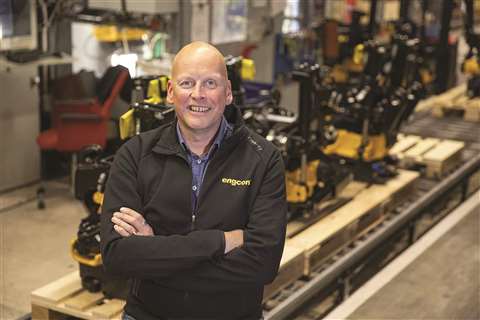 Krister Blomgren, Engcon’s CEO (Photo: Engcon)
Krister Blomgren, Engcon’s CEO (Photo: Engcon)
Engcon is seeing “stable profitability” after reporting record-high net sales for the fourth quarter of 2022.
While the last three months of 2022 saw the company’s order intake decline by 29% SEK553 million (€49.4 million), its net sales increased to SEK541 million (€48.3 million).
This is up 46% on the SEK370 million (€33 million) the company brought in for the same period in 2021 - with operating profits also up 57% on the previous year to SEK 121 million (€10.8 million).
Overall, this resulted in a fourth quarter profit rise of 20%, to SEK 90 million ($8.6 million), up from SEK75 million (€6.8 million) in the fourth quarter of 2021.
Engcon’s fourth quarter results meant that for the whole of 2022 the company saw an order intake rise of 1%, up from SEK1.96 billion (€131.9 million) in 2021 to SEK1.97 billion (€171.4 million).
2022 net sales also increased by 30%, from SEK1.48 billion (€131.9 million) in 2021 to SEK1.93 billion ($186 million), with profits last year amounting to SEK325 million (€29.6 million) - a rise of 21%.
Krister Blomgren, Engcon’s CEO, said, “Combined with increased economic uncertainty, inflation and interest rates, this led to an expected downturn in Nordic and European markets in the fourth quarter compared with exceptional comparative figures. Despite this, the order intake was at a high level when seen from a long-term perspective.
“It is worth noting that there was a break in the trend in 2022, with growth markets recording higher order intake than the Nordic region for the first time.”
Looking to the future, Engcon plans to continue investing in its third generation tiltrotator system and expand its sales network.
STAY CONNECTED



Receive the information you need when you need it through our world-leading magazines, newsletters and daily briefings.
CONNECT WITH THE TEAM








